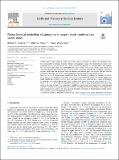Files in this item
Photochemical modelling of atmospheric oxygen levels confirms two stable states
Item metadata
| dc.contributor.author | Gregory, Bethan S. | |
| dc.contributor.author | Claire, Mark | |
| dc.contributor.author | Rugheimer, Sarah | |
| dc.date.accessioned | 2021-03-25T16:30:01Z | |
| dc.date.available | 2021-03-25T16:30:01Z | |
| dc.date.issued | 2021-05-01 | |
| dc.identifier | 273483761 | |
| dc.identifier | 044bc701-35a9-4b17-acb6-d4d61278ec1c | |
| dc.identifier | 85101275051 | |
| dc.identifier | 000631258000010 | |
| dc.identifier.citation | Gregory , B S , Claire , M & Rugheimer , S 2021 , ' Photochemical modelling of atmospheric oxygen levels confirms two stable states ' , Earth and Planetary Science Letters , vol. 561 , 116818 . https://doi.org/10.1016/j.epsl.2021.116818 | en |
| dc.identifier.issn | 0012-821X | |
| dc.identifier.other | ORCID: /0000-0001-9518-089X/work/91340952 | |
| dc.identifier.other | ORCID: /0000-0003-1620-7658/work/91341004 | |
| dc.identifier.uri | https://hdl.handle.net/10023/21721 | |
| dc.description | This work was supported by the European Research Council (ERC) under the European Union's Horizon 2020 Research and Innovation programme (grant no. 678812 awarded to M.W.C). | en |
| dc.description.abstract | Various proxies and numerical models have been used to constrain O2 levels over geological time, but considerable uncertainty remains. Previous investigations using 1-D photochemical models have predicted how O3 concentrations vary with assumed ground-level O2 concentrations, and indicate how the ozone layer might have developed over Earth history. These classic models have utilised the numerical simplification of fixed mixing ratio boundary conditions. Critically, this modelling assumption requires verification that predicted fluxes of biogenic and volcanic gases are realistic, but also that the resulting steady states are in fact stable equilibrium solutions against trivial changes in flux. Here, we use a 1-D photochemical model with fixed flux boundary conditions to simulate the effects on O3 and O2 concentrations as O2 (and CH4) fluxes are systematically varied. Our results suggest that stable equilibrium solutions exist for trace- and high-O2/O3 cases, separated by a region of instability. In particular, the model produces few stable solutions with ground O2 mixing ratios between 6×10-7 and 2×10-3 (3×10-6 and 1% of present atmospheric levels). A fully UV-shielding ozone layer only exists in the high-O2 states. Our atmospheric modelling supports prior work suggesting a rapid bimodal transition between reducing and oxidising conditions, and proposes Proterozoic oxygen levels higher than some recent proxies suggest. We show that the boundary conditions of photochemical models matter, and should be chosen and explained with care. | |
| dc.format.extent | 12 | |
| dc.format.extent | 1428469 | |
| dc.language.iso | eng | |
| dc.relation.ispartof | Earth and Planetary Science Letters | en |
| dc.subject | 1-D photochemical modelling | en |
| dc.subject | Atmospheric evolution | en |
| dc.subject | Oxygen | en |
| dc.subject | Ozone | en |
| dc.subject | Methane | en |
| dc.subject | Proterozoic | en |
| dc.subject | GE Environmental Sciences | en |
| dc.subject | DAS | en |
| dc.subject.lcc | GE | en |
| dc.title | Photochemical modelling of atmospheric oxygen levels confirms two stable states | en |
| dc.type | Journal article | en |
| dc.contributor.sponsor | European Research Council | en |
| dc.contributor.institution | University of St Andrews. St Andrews Centre for Exoplanet Science | en |
| dc.contributor.institution | University of St Andrews. School of Earth & Environmental Sciences | en |
| dc.identifier.doi | 10.1016/j.epsl.2021.116818 | |
| dc.description.status | Peer reviewed | en |
| dc.identifier.url | https://www.sciencedirect.com/science/article/pii/S0012821X21000777?via%3Dihub#se0220 | en |
| dc.identifier.grantnumber | 678812 | en |
This item appears in the following Collection(s)
Items in the St Andrews Research Repository are protected by copyright, with all rights reserved, unless otherwise indicated.

